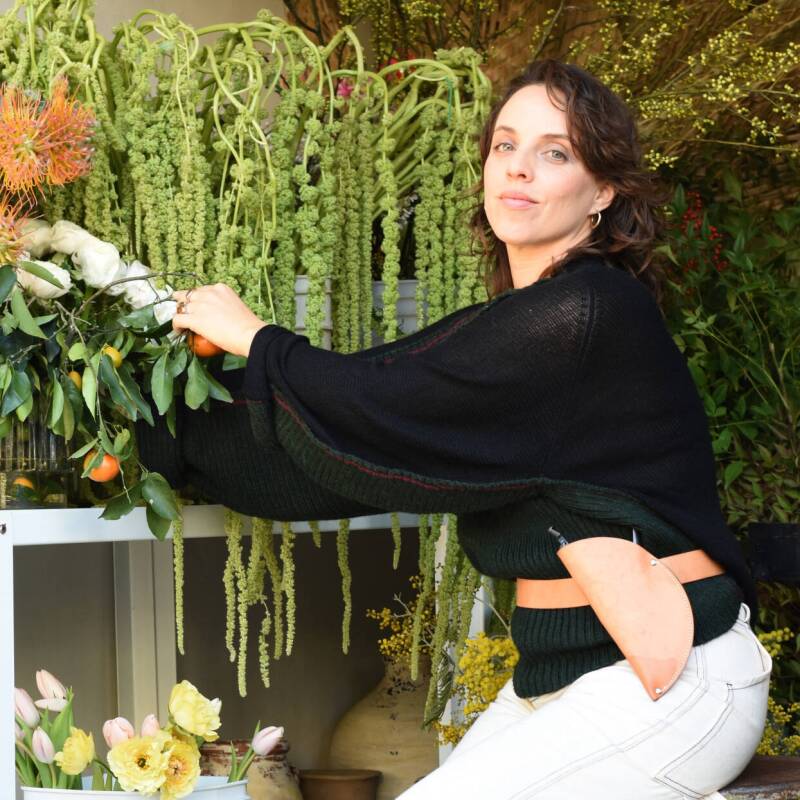While I try to live in the moment as much as possible, it’s harder to be mindful when it c0mes to garden design. After all, planning ahead for the next season is often the key to a beautiful four-season garden. As summer chugs along, I’m already thinking about what flowers will be blooming in the months ahead and what will be supportive to our pollinator friends.
Here are some favorite late bloomers I’m considering for my and my clients’ gardens this fall:
Chrysanthemum

I know what you’re thinking: those supermarket flowers? But take a closer look at the more unique varieties that have hit the market. I totally swoon over the spider, quilled, and pom pom ones, and you might, too. These long-lasting cut flowers boasts autumnal colors and are superbly sturdy, making them a great addition to a cut flower garden. Also, because they contain pyrethrum, a natural insect repellent, consider planting some on the edges of a vegetable bed to ward off nibbly invaders. Hardy in USDA Zones 3-9. Best planted in full sun and soil that drains well. (See Gardening 101: Chrysanthemums.)
Aster

Come late summer, when many flowers start fading, asters are here for the bees, butterflies, and other pollinator pals. Depending on the variety, some asters grow to around a foot tall, while others tower to 6-plus feet; they can range in color from purple to blue and white. Plant in a partly sunny to full sun spot with soil that drains well. Potentially deer-resistant as well. I’m fond of Aster chilensis as it is a vigorous California native perennial with pale lilac flowers and is a great butterfly nectar plant. Hardy in USDA Zones 3-8.
Black-Eyed Susan

A fall favorite, Rudbeckia hirta is also beloved by pollinators and looks fantastic when planted with ornamental grasses for a meadow effect. Growing from 1 to 3 feet, they make great cut flowers and thrive in a sunny spot. Make sure to deadhead the flowers to promote blooming, and then at the end of the season leave the seed heads for the birds to snack on. Favorite hybrids include ‘Prairie Sun’, ‘Sonora’ and ‘Autumn Colors’. Hardy in USDA Zones 3-9. See also Gardening 101: Black-Eyed Susans.)
Anise Hyssop

Contrary to what might be assumed, anise hyssop (Agastache foeniculum) plant is not anise but is instead in the mint family and the leaves exude a spicy scent similar to licorice. Adored by pollinators and detested by deer, this perennial produces long lasting purplish blooms that can be used in flower arrangements. The vertical habit pairs well with cascading ornamental grasses and other fall-blooming favorites. A sunny spot is best. USDA Zones 4-8.(See also Gardening 101: Hyssop.)
Japanese Anemone

Need a charming, fairy-tale flower for fall? Japanese anemone, also called windflower, is a perennial with upright dainty stems topped with white, pinky, or purplish flowers that kick the end of summer/fall season into high gear. Easy to grow (actually this plant grows almost too easy in moist soil and can spread willy nilly if left alone to its own devices, so be prepared). Part sun is best; stems may flop over if they don’t get enough sunlight. Perfect for woodland, cottage, or traditional beds. Hardy in USDA Zones 4-8.
Coneflower

Also commonly known as echinacea, the OG Echinacea purpurea holds colorful rosy petals surrounding an orange prickly cone-like center. Cool Fact: the genus is named after the Greek word for hedgehog: echinos. New coneflower varieties have arrived that offer a broader color palette and different flower shapes, but all are loved by bees and butterflies. And once seed heads form in the fall, the songbirds will go berserk. Perfect when planted in masses in a wildflower meadow, perennial bed, or medicinal garden. Full sun is best with well-draining soil. Hardy in USDA Zones 3-9. (See also Gardening 101: Coneflower.)
Zinnia

A top butterfly-attracting annual, cheery zinnias are certainly going to brighten up a garden and provide you with endless long-lasting cut flowers. Available in a range of sizes and colors, these easy annuals come in three main types: single, semidouble, and double. I like to grow my zinnias from seed in the spring because they are super easy, but you can also purchase some starts from your local nursery. For maximum blooms, choose a sunny spot with good air circulation to avoid powdery mildew and deadhead routinely. (See also Gardening 101: Zinnias.)
Coreopsis

Also known as tickseed (it’s round seeds resembling ticks), this daisy-like flower is not only low-maintenance but also low-thirst. With routine deadheading, this perennial will bloom from summer until the first frost and will please pollinators, to boot. A full sun spot with well-draining soil is much appreciated. A unique variety to look for is ‘Cosmic Eye’ with beautiful bi-color blooms. Hardy in USDA Zones 4-9.
See also:
- Fall Fertilizing: How to Prepare Your Lawn, Shrubs, Trees, and Perennials for a Restorative Winter Sleep
- Late-Fall Planters: 7 Tips for Beautiful, Long-Lasting Autumn Container Gardens
- Fall Gardening 101: Autumn Can Be an Ideal Time to Plant. Here’s Why.












Have a Question or Comment About This Post?
Join the conversation (0)